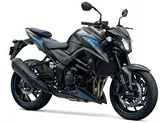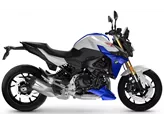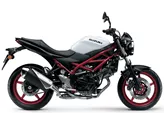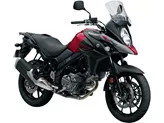Suzuki SV 650 2017 vs. Kawasaki Z900 2017

Suzuki SV 650 2017

Kawasaki Z900 2017
Overview - Suzuki SV 650 2017 vs Kawasaki Z900 2017
The Suzuki SV 650 2017 and the Kawasaki Z900 2017 are both naked bikes with their own unique features and specifications.
Starting with the engine and drive train, the Suzuki SV 650 2017 is equipped with a V-twin engine that produces 76 horsepower and 64 Nm of torque. It has a fuel injection system and a displacement of 645cc. On the other hand, the Kawasaki Z900 2017 features an in-line four-cylinder engine that delivers a more powerful 125.4 horsepower and 98.6 Nm of torque. It also has a fuel injection system and a larger displacement of 948cc. Both bikes have liquid cooling to ensure optimal engine performance.
In terms of suspension, the Suzuki SV 650 2017 comes with a telescopic fork front suspension and a swing arm rear suspension with a monoshock absorber. The chassis is made of steel and has a tubular frame. The front brakes are double disk with a diameter of 290mm and double piston calipers. The bike also features ABS for advanced rider assistance. The front tire has a width of 120mm and a diameter of 17 inches, while the rear tire has a width of 160mm and the same diameter.

Suzuki SV 650 2017
Similarly, the Kawasaki Z900 2017 has a swing arm rear suspension with a monoshock absorber, but its front suspension is an upside-down telescopic fork. The chassis is also made of steel, but it has a double cradle frame type. The front brakes are double disk with a larger diameter of 300mm and four piston calipers. Like the SV 650, it also features ABS. The front tire has the same width and diameter as the SV 650, but the rear tire is wider at 180mm.
In terms of dimensions and weights, the Suzuki SV 650 2017 has a wheelbase of 1445mm and a seat height of 785mm. The kerb weight, including ABS, is 197kg. On the other hand, the Kawasaki Z900 2017 has a slightly longer wheelbase of 1450mm and a slightly higher seat height of 795mm. The kerb weight, including ABS, is slightly heavier at 210kg.

Kawasaki Z900 2017
Now let's discuss the strengths and weaknesses of each bike. The Suzuki SV 650 2017 is praised for its smooth engine, playful handling, and great chassis. However, one weakness mentioned is that the brakes are considered too weak.
On the other hand, the Kawasaki Z900 2017 is praised for its ingenious naked bike chassis, superb looks, and a powerful engine that responds well and has perfectly dimensioned torque. It is also considered to be an optimum intersection of performance, price, and practical use. However, one weakness mentioned is that the knee angle may be too narrow for tall people, and it is recommended to order another seat for better comfort.
In conclusion, both the Suzuki SV 650 2017 and the Kawasaki Z900 2017 have their own unique features and strengths. The SV 650 offers a smooth engine and playful handling, while the Z900 offers a more powerful engine and a well-designed chassis. However, it is important to consider personal preferences and requirements when choosing between these two bikes.
Technical Specifications Suzuki SV 650 2017 compared to Kawasaki Z900 2017
Pros and Cons in comparison
Pros and Cons in comparison
Suzuki SV 650 2017

The Suzuki SV 650 is accompanied by a long history of success that is sure to continue for a long time. Its supple V2 impresses with very smooth response and plenty of torque. Compact dimensions help to make the motorbike look very compact. This will be very convenient for beginners. The chassis also scores with playful handling. Unfortunately, the braking effect is not at the level one would expect from such a powerful vehicle.
Kawasaki Z900 2017

An incredibly well-designed motorbike. A lot of test work and attention to detail went into it. It has exactly the right power, exactly the right chassis and exactly the right look. An all-round successful naked bike that will make you happy for a long time. If you like, you can ride it simply and faithfully, but if you want, you can also ride it really fast and it wheels like hell. Great!
Price Comparison Avarage Market Price Suzuki SV 650 vs Kawasaki Z900
There are a few key differences between a Suzuki SV 650 2017 and a Kawasaki Z900 2017. In terms of price, the actual average price of a Kawasaki Z900 2017 is about 52% higher. Compared to Kawasaki Z900 2017 there are less Suzuki SV 650 2017 bikes available on the 1000PS.de Marketplace, specifically 6 compared to 43. It takes less time to sell a Kawasaki Z900 with 85 days compared to 112 days for the Suzuki SV 650. Since model year 2005 1000PS.de editors have written 25 reviews for the Suzuki SV 650 and 46 reviews for the Kawasaki Z900 since model year 2017. The first review for the Suzuki SV 650 was published on 9/26/2008 and now has more than 14,200 views. This compares to more than 93,200 views for the first review on Kawasaki Z900 published on 11/11/2016.

















